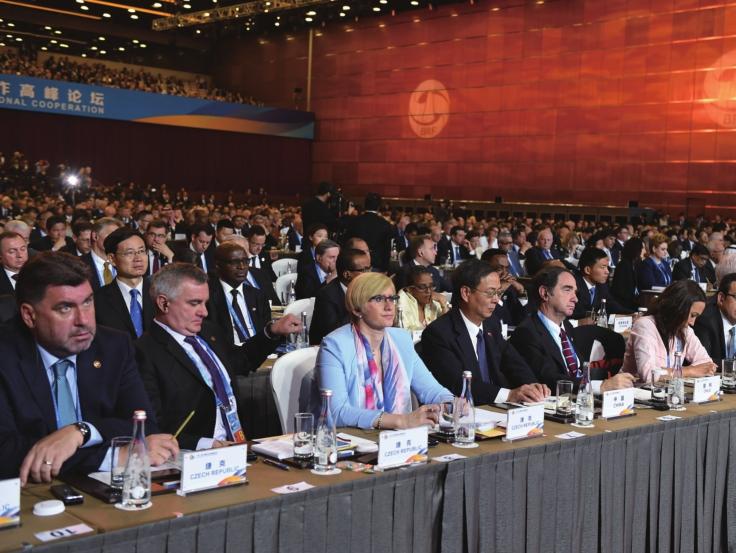Cementing Gains
2019-04-15



On November 17, 2018, Chinese President Xi Jinping announced that the Second Belt and Road Forum for International Cooperation (BRF) would be held in April 2019 in Beijing, drawing interest from both Chinese and foreign media. Yang Jiechi, member of the Political Bureau of the Central Committee of the Communist Party of China and Director of the Office of the Central Commission for Foreign Affairs, who has overseen the preparations for the forum, gave an interview to Peoples Daily and China Daily on March 29. He talked about the progress in pursuing Belt and Road cooperation and preparations for the forum.
Close to six years since it was put forth by President Xi, the Belt and Road Initiative has become a widely welcomed international public goods with a far-reaching and profound impact on the world. What role has the initiative played in deepening international cooperation, promoting closer ties between countries and boosting global growth? Is there any underlying link between it and the vision of building a new type of international relations and a community with a shared future for humanity?
Yang Jiechi: The Belt and Road Initiative is an important initiative for international cooperation proposed by President Xi to enhance both Chinas development and its cooperation with global partners. The initiative represents a major breakthrough in both theory and practice and carries far-reaching signifi cance.
Since its inception, it has received strong endorsement and warm support from the international community. So far, a total of 124 countries and 29 international organizations have signed Belt and Road cooperation documents with China. Most recently, during President Xis visit to Italy, the two countries signed a memorandum of understanding on promoting Belt and Road cooperation, giving a new impetus to the process. Meanwhile, the initiatives vision has been included in documents of major international institutions including the United Nations, the Group of 20, the Asia-Pacifi c Economic Cooperation and the Shanghai Cooperation Organization. Indeed, it has proved a popular and worthy cause that follows the international trend and responds to the shared aspiration of countries for development through mutually benefi cial cooperation. Looking back at this pursuit over the last few years, I would like to draw your attention to the positive role the Belt and Road Initiative has played in the following three ways:
First, the initiative has opened a new area for international cooperation and boosted confi dence in it.

The world today is experiencing profound changes not seen in a century. Protectionism and unilateralism are rising, so are uncertainties and destabilizing factors. As stressed by President Xi, the Belt and Road Initiative is a signifi cant move by China to fully open up under the new conditions, and it embodies Chinas commitment to sharing development opportunities and outcomes with more countries in the world. This important statement charts the course for Belt and Road cooperation.
The initiative is guided by the principle of consultation and cooperation for shared benefits. It represents an approach to international cooperation featuring mutual respect, justice, equity and cooperation for win-win outcomes; it is a commitment to multilateralism and an open global economy. As such, the Belt and Road Initiative will help move economic globalization toward greater openness, inclusiveness, balance and win-win outcomes.
Second, the initiative has created new impetus and opportunities for global growth.
Since the outbreak of the international financial crisis in 2008, creating both new growth drivers and a new cycle of global growth has become a common task for the international community. The Belt and Road Initiative aims to address the fundamental issue of promoting development by enhancing all-around connectivity. It has helped countries involved to remove development bottlenecks and implement the UN 2030 Agenda for Sustainable Development, thus becoming an important way to boost global growth.
The latest studies by the World Bank and other international institutions suggest that Belt and Road cooperation will cut the costs of global trade by 1.1-2.2 percent and those of trade along the China-Central AsiaWest Asia Economic Corridor by 10.2 percent. Furthermore, it will contribute at least 0.1 percent of global growth in 2019.
Third, the initiative provides a new platform and opportunities for fostering closer ties between countries.
By improving connectivity between countries, Belt and Road cooperation has strengthened economic ties and peopleto-people exchanges, thus binding them closer together with shared interests. This will naturally build extensive consensus, enhance cooperation and ultimately promote development for all.
As President Xi pointed out, the initiative aims to replace estrangement with exchanges between different civilizations, clashes with mutual learning and a sense of superiority with coexistence. It also aims to boost mutual understanding, mutual respect and mutual trust among different countries. Therefore, it is a sure path toward peace and cooperation for win-win outcomes.
The vision of building a new type of international relations and a community with a shared future for humanity is an important component of Xi Jinping Thought on Diplomacy. The Belt and Road Initiative champions mutual respect, consultation on an equal footing, openness and inclusiveness, and mutual benefi ts. It is an approach to global governance featuring consultation and cooperation for shared benefits and it aims to promote connectivity throughout the world. These are all important dimensions of the vision of a community with a shared future for humanity and a new type of international relations.

The Belt and Road Initiative is a new path for state-to-state relations based on dialogue rather than confrontation, partnership rather than alliance and mutual learning and enrichment. It supports the multilateral trading system and embraces an economic globalization that is more open, inclusive and balanced so that its benefi ts can be shared by all. The initiative is therefore an important platform for building a community with a shared future for humanity and a new type of international relations.
President Xi has emphasized on various occasions that while the Belt and Road Initiative was launched by China, its benefits should be shared by the world. It aims to enhance connectivity in policy, infrastructure, trade, finance and people-to-people ties, and good progress has been made in all these areas over the last six years. Against the backdrop of Chinas foreign relations, how do you assess the progress made in pursuing Belt and Road cooperation? What benefits has it brought to participating countries?
Since the Belt and Road Initiative was first proposed close to six years ago, cooperation under it has seen major progress and proved more fruitful than planned.
First, there is growing complementarity between it and the development plans and policies of various parties.
At the global level, the initiative is well aligned with the UN 2030 Agenda for Sustainable Development, thus forming a synergy of policies to promote global development.
At the regional level, it connects regional development plans and cooperation initiatives such as the Master Plan on ASEAN Connectivity, the African Union Agenda 2063, the Eurasian Economic Union and the Europe-Asia Connectivity Strategy of the European Union, thus creating a synergy for improving connectivity and supporting economic integration among regions of the world. During President Xis recent visit to France, the two countries agreed to jointly promote Belt and Road cooperation in the form of cooperation in third markets, and a list was signed on the third batch of demonstration projects on third-market cooperation.
Second, the initiative has boosted global connectivity.
Guided by the principle of consultation and cooperation for shared benefits and by enhancing connectivity in the five priority areas of policy, infrastructure, trade, fi nance and people-to-people ties, the initiative has given a strong boost to international cooperation on connectivity.
To be more specific, the joint endeavor to promote the initiative has deepened international cooperation on physical connectivity within the basic framework of “six economic corridors, six connectivity networks, and multiple countries and ports in different parts of the world.” It has also strengthened cooperation on institutional connectivity including policies, rules and standards.
Development of major transport links such as the China-Europe Railway Express and the new land-sea corridor is making a big difference; cooperation on transnational economic corridors is being intensified; construction of infrastructure projects of railways, ports, motorways and pipelines, as well as economic and trade cooperation parks, is proceeding smoothly.
Third, the international platform for Belt and Road cooperation has been steadily strengthened.
The BRF is the highest-level platform for Belt and Road cooperation, where all parties concerned meet to build consensus and adopt plans for future cooperation. We have set up a BRF Advisory Council consisting of leading international fi gures to provide advice on the growth of the forum. In addition, China and other participating countries have in recent years set up platforms for multilateral cooperation on port, shipping, finance, taxation, energy, culture, think tank, the media and other areas, and launched initiatives on a green and clean Silk Road.
Fourth, the initiative has delivered fruitful outcomes in boosting economic growth and improving peoples lives in participating countries.
Through Belt and Road cooperation, some countries now have their first motorways or modern ra ilways, some have developed their own car industry, while others have seen an end to their longstanding power shortages.
Thanks to Belt and Road cooperation, Kazakhstan, the worlds largest landlocked country, has gained access to the Pacifi c Ocean through the Lianyungang Port in China, and the China-Kazakhstan logistics terminal has become an international economic platform of cross-border transportation, warehousing, logistics and trade for many other Central Asian countries.

Due to regular China-Europe Railway Express freight services, the number of Chinese companies operating in Duisburg, Germany, has grown from 40 in 2014 to more than 100 today. Statistics from the Duisburg City Council showed that in the citys logistics sector alone, these freight services have created more than 6,000 jobs.
Since it was leased to a Chinese company, the Piraeus Port in Greece has become one of the fastest growing container ports in the world, soaring to 36th place in global container traffic from 93rd in 2010. The port has about 10 Chinese staff members but employs 3,000 Greeks, and it has also created more than 10,000 indirect local jobs.
Chinese investment in Egypt has made the country the worlds third largest producer of fi berglass, and a large number of technical and managerial professionals have been trained. The 82 cooperation parks jointly built by China and other participating countries have created more than $2 billion in tax revenue and a total of about 300,000 jobs in host countries. The list of Belt and Road success stories can go on and on.
All these stories fully demonstrate that the initiative has provided good opportunities for all parties involved to jointly address global challenges, promote global growth and achieve common prosperity through greater connectivity. But this is only the beginning, there is a lot more we can accomplish by pursuing this cooperation initiative. China will continue to work with all other parties to create even more opportunities and deliver even more fruitful outcomes.
Efforts made over the past six years have laid a solid foundation for Belt and Road cooperation. What are the new opportunities under the new conditions? How will such cooperation be deepened and substantiated? Although the initiative is generally applauded and supported by the international community, we have also heard some different views or even doubts expressed against it. What is your response?
Through six years of hard work, the Belt and Road Initiative has laid its groundwork and entered the stage of all-around growth; it is bearing fruit and will create more opportunities for cooperation.
The opportunities come with the initiatives growing international influence, moral appeal and cooperation potential. Against the backdrop of mounting protectionism and unilateralism in the world, its principle of consultation and cooperation for shared benefits has gained wide recognition. Support for the initiative is the mainstream view of the international community, and the opportunities created by Belt and Road cooperation are widely appreciated in the global community.
The opportunities come with the growing complementarity among the development strategies and plans of all Belt and Road partners, from the solid gains achieved in cooperation across the board, and from progress in bilateral, trilateral and multilateral cooperation. As such, a strong foundation has been laid for quality Belt and Road cooperation.
The opportunities come with the accelerated industrialization of a vast number of developing countries, a process which generates new demands in infrastructure connectivity and industrial investment, and promises huge potential for international cooperation.
The opportunities also come with the transition of the Chinese economy toward quality development. As China opens its door wider to the world, more opportunities are being created for other countries to participate in Belt and Road cooperation and enter the huge Chinese market.
At the seminar marking the initiatives fi fth anniversary last August, President Xi highlighted the need to move Belt and Road cooperation toward quality development. This is the goal we are striving to achieve. To this end, we will work vigorously to harness development opportunities, further enhance the complementarity of the development strategies of various parties, ensure that projects launched meet high quality standards, and further promote international cooperation.
We have noticed that some people have expressed different views about the Belt and Road Initiative, claiming that it is Chinas geopolitical tool and could cause some countries to fall into a so-called debt trap. Such views are less than objective or balanced. They are simply a misunderstanding, misrepresentation and even biased view of the initiative.
We have stressed on many occasions that it is for economic cooperation that supports common development. All parties involved are equal participants that have all contributed to the initiative and benefited from it. It is open, inclusive and transparent; it does not harbor any hidden geopolitical agenda, nor is it designed to form an exclusive circle or impose discriminatory trade terms on others.
No one is in a better position to repudiate the so-called debt trap allegation than Belt and Road participants themselves. As a matter of fact, the
governments, business communities and the general public of many countries that have participated in and benefi ted from the initiative have spoken up and debunked such groundless assertions with facts and fi gures.
Decisions made under the Belt and Road framework, from project selection to investment and fi nancing cooperation, are all based on full consultation among the parties and on the basis of conducting due risk assessment and investment feasibility studies.
China and another 27 countries have jointly adopted the Guiding Principles on Financing the Development of the Belt and Road, which highlights the need to ensure debt sustainability in project fi nancing. In case our cooperation partners face difficulties in servicing debts, China will properly address this issue through friendly consultation and will never press for debt payment. As a matter of fact, no country has gotten trapped in a debt crisis since they began to participate in the initiative. On the contrary, it is through participating in Belt and Road cooperation that many countries have gotten out of the trap of “no development.”
The First BRF hosted by China in May 2017 was a complete success. President Xi announced that China will hold the second BRF in April 2019. What is the theme of this forum? What activities will be held? What outcomes does China expect from this years forum?
The BRF is the top-level platform for international cooperation under the Belt and Road framework. In May 2017, the First BRF was successfully held in Beijing, which produced positive consensus on Belt and Road cooperation and delivered fruitful outcomes. In response to the wishes of the participating parties, President Xi announced at the fi rst forum that China would hold the Second BRF sometime in 2019.
Through consultation with all other parties, we have decided to hold the Second BRF in Beijing in late April this year. President Xi has sent invitations to the leaders of relevant countries for participation in the Second BRF. The theme of this years forum is Belt and Road Cooperation: Shaping a Brighter Shared Future. Forum events include an opening ceremony, a leaders roundtable, a high-level meeting, thematic forums, a CEO conference and other side events.
Representatives from over 100 countries, including some 40 leaders of foreign governments, have confirmed their attendance. As the host country, we will, along with other forum participants, take stock of what has been achieved and draw a blueprint for future cooperation to further enrich Belt and Road cooperation.
We hope that participating parties will further enrich the vision of advancing quality Belt and Road cooperation.
